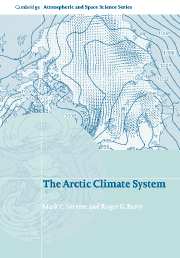Book contents
- Frontmatter
- Contents
- Preface page
- Acknowledgements
- List of Abbreviations
- 1 The evolution of knowledge about the Arctic and its climate
- 2 Physical characteristics and basic climatic features
- 3 The basic atmospheric heat budget
- 4 The atmospheric circulation
- 5 The surface energy budget
- 6 Precipitation, net precipitation and river discharge
- 7 Arctic ocean–sea ice–climate interactions
- 8 Climate regimes of the arctic
- 9 Modeling the arctic climate system
- 10 Arctic paleoclimates
- 11 Recent climate variability, trends and the future
- References
- List of selected websites
- Index
- Plate Section
8 - Climate regimes of the arctic
Published online by Cambridge University Press: 10 August 2009
- Frontmatter
- Contents
- Preface page
- Acknowledgements
- List of Abbreviations
- 1 The evolution of knowledge about the Arctic and its climate
- 2 Physical characteristics and basic climatic features
- 3 The basic atmospheric heat budget
- 4 The atmospheric circulation
- 5 The surface energy budget
- 6 Precipitation, net precipitation and river discharge
- 7 Arctic ocean–sea ice–climate interactions
- 8 Climate regimes of the arctic
- 9 Modeling the arctic climate system
- 10 Arctic paleoclimates
- 11 Recent climate variability, trends and the future
- References
- List of selected websites
- Index
- Plate Section
Summary
Overview
The Arctic is home to a wide variety of climate conditions. This spectrum reflects, among other things, regional characteristics of the atmospheric circulation, elevation, distance from moisture sources (continentality), and the properties of the underlying surface. The present chapter both summarizes and builds upon what we have already learned through a focus on some of these different climatic regimes. Up to now, relatively little attention has been paid to the Greenland Ice Sheet. This region is hence given special emphasis.
The Greenland Ice Sheet represents an extensive high elevation surface for which the albedo remains high throughout the year. While these features distinguish its climate from other regions of the Arctic, ice sheet climates are nevertheless quite varied. The interior is very cold and dry, with summer temperatures well below freezing. Annual precipitation over the central part of the ice sheet, isolated from moisture sources, is around 100–200 mm. By comparison, the southeast coast is relatively warm and very moist. This region is strongly influenced by the North Atlantic cyclone track. Locally, in favored areas of orographic uplift, precipitation may exceed 2000 mm. Precipitation is also fairly high along much of the west coast (600 mm). The southern parts of the ice sheet and the coastal regions experience summer melt. Some particularly interesting aspects of the ice sheet are its pronounced katabatic wind regime, related to radiational cooling, and the significant role of sublimation on the moisture budget.
- Type
- Chapter
- Information
- The Arctic Climate System , pp. 208 - 228Publisher: Cambridge University PressPrint publication year: 2005



